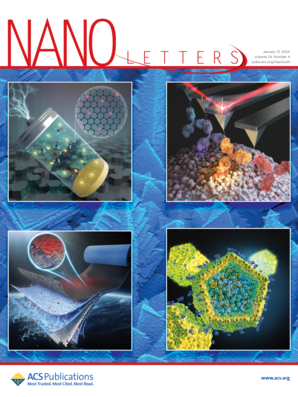阱诱导多发射中心构建的碳点室温余辉随时间的变化
IF 9.1
1区 材料科学
Q1 CHEMISTRY, MULTIDISCIPLINARY
引用次数: 0
摘要
陷阱,由于其捕获、储存和释放载流子的能力,在长余辉材料的构建中引起了极大的关注。本研究采用一步原位煅烧的方法制备了碳点(CD)基复合材料,并设计了捕集器作为复合材料体系的发射中心之一。去除紫外光后,材料呈现出随时间变化的余辉颜色(TDAC),发光颜色逐渐由橙色变为绿色。研究表明,动态余辉是由于能量从陷阱态转移到cd表面三重态的结果。此外,原位煅烧过程中产生的CDs作为掺杂剂,增加了原有陷阱的数量,并促进了新陷阱的形成。基于TDAC的特点,介绍了其在防伪和信息加密方面的应用。这一策略为多色余辉材料的发展提供了新的见解。本文章由计算机程序翻译,如有差异,请以英文原文为准。

Time-Dependent Room-Temperature Afterglow of Carbon Dots Constructed by Trap-Induced Multiemission Centers
Traps, due to the ability to capture, store, and release charge carriers, have attracted significant attention in the construction of long afterglow materials. In this study, a one-step in situ calcination strategy was employed to fabricate carbon dot (CD)-based composites, and the traps were designed as one of the emission centers within the composite system. Upon removal of ultraviolet light, the materials showed a time-dependent afterglow color (TDAC), with the luminescent color gradually changing from orange to green. The study indicates that the dynamic afterglow results from the energy transfer from traps to the surface triplet state of the CDs. In addition, CDs generated during the in situ calcination process serve as dopants, increasing the number of original traps and facilitating the formation of new ones. Based on the TDAC characteristics, we demonstrate the applications in anti-counterfeiting and information encryption. This strategy offers new insights into the development of multicolor afterglow materials.
求助全文
通过发布文献求助,成功后即可免费获取论文全文。
去求助
来源期刊

Nano Letters
工程技术-材料科学:综合
CiteScore
16.80
自引率
2.80%
发文量
1182
审稿时长
1.4 months
期刊介绍:
Nano Letters serves as a dynamic platform for promptly disseminating original results in fundamental, applied, and emerging research across all facets of nanoscience and nanotechnology. A pivotal criterion for inclusion within Nano Letters is the convergence of at least two different areas or disciplines, ensuring a rich interdisciplinary scope. The journal is dedicated to fostering exploration in diverse areas, including:
- Experimental and theoretical findings on physical, chemical, and biological phenomena at the nanoscale
- Synthesis, characterization, and processing of organic, inorganic, polymer, and hybrid nanomaterials through physical, chemical, and biological methodologies
- Modeling and simulation of synthetic, assembly, and interaction processes
- Realization of integrated nanostructures and nano-engineered devices exhibiting advanced performance
- Applications of nanoscale materials in living and environmental systems
Nano Letters is committed to advancing and showcasing groundbreaking research that intersects various domains, fostering innovation and collaboration in the ever-evolving field of nanoscience and nanotechnology.
 求助内容:
求助内容: 应助结果提醒方式:
应助结果提醒方式:


